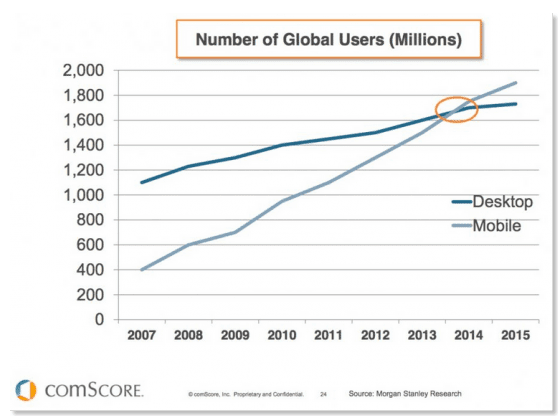This blog post is part of “The Ultimate Guide to Web Development” and “The Ultimate Guide to SEO” blog series.
If you’re website is not optimized for mobile search, you are likely losing mind share and market share. Don’t believe it? Let’s look at the numbers.
Mobile internet use surpassed desktop use two years ago. If you are only optimized for desktop search and navigation, you’re falling behind.

It’s growing faster too
On Google alone, there are 2.3 million searches per second. More than half are from mobile devices. Mobile search is growing at a clip of 58 percent per year. Do the math. It’s not too complicated. If your site is not mobile friendly, you’re losing at least half the searches taking place.
81 percent of people prefer mobile search
The mantra of yesterday was “make it work on mobile.” The mantra of today is “mobile first.” Why? Because that’s what people want. People like searching on their phones–at least 81 percent do. That wasn’t the case 10 years ago when screens were tiny and brands paid scant attention to the mobile experience. Sites were hard to read and slow to load. Now the race is on to deliver a delightful mobile experience.
They really like it!
A whopping 77 percent of people search on their mobile devices while at home or at work. That means they’re near their desktop or laptop computer and they choose their smartphone or tablet for browsing instead of the larger device. Wow!
Google will penalize you even if you don’t have mobile users
Google search rankings will ding your website if it delivers a poor mobile experience, even if you have few mobile visitors. It doesn’t matter. It is that important to the search engine. It rewards mobile friendless. Remember “mobilegeddon” in 2015? That’s when Google changed their search ranking algorithm to favor mobile friendly website.
Your competitors are doing it
A survey of IT decision makers in 2013 said that only 7 percent of companies had a fully implemented mobile app strategy in place, with 51 percent having absolutely none. In 2015, 52 percent of companies had a fully implemented mobile strategy and only 11 percent didn’t, according to Red Hat’s Mobile Maturity Survey 2015. This year, 90 percent of companies said they plan to invest in mobile and only 10 percent said they had no plans to do so.
Mobile searches turn into purchases
Mobile commerce consulting firm Convince and Convert found that 70 percent of mobile searchers make a purchase within an hour. Do you need any more convincing?
It’s not just B2C
Even if you’re a B2B company without a “click-to-buy” product, your website should still be optimized for mobile search and browsing. According to Google, 42 percent of B2B researchers use mobile during the B2B purchasing process. That’s 3x growth since 2012.
How do you know if your website is mobile friendly?
Google has a great Mobile Friendly Test. All you have to do is enter a web address and it will rank your site and give you specific recommendations for improvement. That’s a good place to start. It’s not too late
It’s not too late
Because so many businesses are optimizing their sites for mobile search, there are lots of resources available to make it easier and faster. There are more tools, plugins, and widgets that can shortcut the development process. Also, Google has made the criteria for mobile friendliness pretty transparent, so there isn’t a lot of guesswork involved. So get started!
This blog post is part of “The Ultimate Guide to Web Development” blog series.




